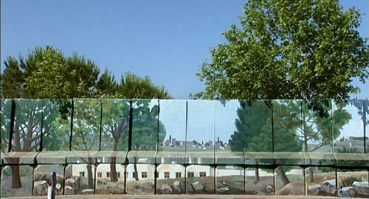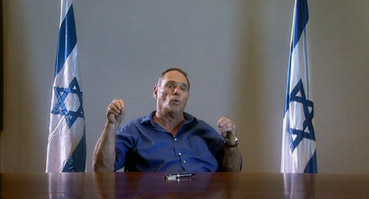| |
"In this part of the world, unfortunately, the normal is the exception. It is the irrationality and the abnormality, the racism and the extremism that is prevailing today
in the Holy land which has been taken by the Devil." |
| |
A
videophone message from Gaza |
The
Israeli-Palestinian conflict is one that can provoke strong,
one might even say extreme reactions. I myself have had
to step in to stop a shouting match on the subject from
developing into a punch-up, and have listened to otherwise
perfectly rational people make outrageously sweeping statements
about one side or the other. One of the most frequently
repeated comments casts every Palestinian as a potential terrorist,
a view given undue weight by the might of the Israeli state and
its influence in the West. It is this belief that was
at the heart of the decision by the Israeli government to
erect a 681 kilometre barrier along the West Bank to divide
the Israeli and Palestinian population of the region. The
project is a long term one that will take many years to
complete and is being constructed from a mixture of interlocking concrete sections,
vehicle trenches and densely packed barbed wire. By January
2006, three years after the project commenced, approximately
31% was completed and a further 31% was under construction.
Supporters of the barrier refer to it as The Fence. Its
opponents call it The Wall.
Documentary
film-maker Simone Britton uses her Jewish-Arab background to examine the nature of the barrier and its effect on
the population living around it from both sides of the divide.
In the process, she encounters some unsurprising attitudes,
from those on the Palestinian side who equate it to a prison
wall, to the claim made by director general of the Israeli
Ministry of Defence General Amos Yaron that it is a necessary weapon against
Palestinian criminal and terrorist activity. But Britton also
uncovers some intriguing examples that kick against the
expected, most memorably the Arab construction workers who
are helping to build the barrier, grateful for the work
in an area with few job opportunities and no social security.

The
film kicks off in captivating fashion with a close to three
minute track along a lengthy section of the wall that has
been fabulously decorated in a variety of artistic styles,
while the off-camera voices of Israeli children explain
to the enquiring Britton the purpose of the wall. "They
shoot Arabs from here," says one, only to have his
friend say, "No. Arabs shoot at us." "Who
shoots at who?" Britton pertinently asks, but gets
no reply. It is just such casually delivered comments that
provide some of the film's most insightful moments, as pedestrians approach the film-makers and pass comment on the barrier
and its impact on their lives.
Often
arrestingly shot, the editing pace seems almost too leisurely
at times, with shots held for far longer than would normally
be expected and not always with obvious purpose, creating
the sense of an hour-long film that has been stretched out
to 90 minutes. Actions and places are observed, and lingering
on them sometimes creates the sense of a point being laboured. But more often than not the message is conveyed
precisely by letting the shot roll on uninterrupted, as
with the Israeli patrol guard who checks
the identity of Palestinians attempting to pass through
the barrier but who ends up stopping a succession of Israeli
citizens leaving an area in which they should not have been in the first place and
admonishing them with steadily increasing severity.
Britton
and her crew never appear on camera but intermittently become
part of the story they are telling, as they are questioned
by passers-by, challenged by a soldier only after they have
spent some time filming him, and asked if they feel unsafe
working in the area by an Israeli who believes that the barrier
is an ultimately ineffective waste of money. It is he who
brings the reality of suicide bombings down to a personal
level. "Have you ever found yourself standing next
to a bus?" he asks Britton. "When you stand next
to a bus, pray for the light to be green. That's what I
do." Anyone with even a passing knowledge of the area's
troubles will understand the implications of that statement.

The politics of the situation are never really engaged or
even introduced, and a degree of knowledge of the conflict,
the locale, and even the wall itself is assumed. The film
focusses not on the wider issues, but on the barrier and those living within its metaphorical shadow. Although
largely even-handed in its range of interviews, the wall
is never really seen in a positive light, making large profits
for an Israeli concrete manufacturing firm but robbing land
from Palestinian farmers, on whose side of the divide the
barrier has been constructed. Neighbourhoods find themselves
cut in half, frustrating even those on the Israeli side
who would like to get to know those who live just a few
metres away, while others find their route to work now blocked.
One Palestinian man even tells of a social divide within
his own family, separating those who have Jerusalem ID cards
from those who do not. It is perhaps a little ironic that
the most passionate and reasoned case made against the social
injustice of the barrier is made not by a penniless West
Bank inhabitant, but a comfortably-off Israeli.
Although Wall tends to nibble where I wish it would
bite, these nibbles are numerous and cumulatively effective.
Even Amos Yaron presents the case for the barrier in increasingly
unconvincing terms, becoming gradually agitated with the
questioning and detailing an overkill of security measures
that are shown to be completely ineffective when locals
are filmed moving freely and easily across the divide. But it's the small moments, the lingering
shots that at first seem a little too lingering,
that really hit home – the landscape slowly blocked out
of the picture by concrete wall segments, the village dominated
by an armed watch tower that sits on the hill above, the
segment of wall that has been lovingly painted to resemble
the more tranquil scene that lies beyond it.
Britton
ends her film on a repeat of the opening shot, but on a
section of the wall where there are no paintings to beautify
this concrete and wire exercise in social division and control,
only scrawled graffiti. Here the wall is already in disrepair,
patched up by concrete blocks and topped by ragged barbed
wire. It is here that the dour reality and ugliness of the
project is most poetically expressed, and as we watch one
girl effortlessly scale it and an old woman holding her
hand against the concrete as if attempting to reach beyond
its confines, the cruelty and pointlessness of the multi-million
dollar construct is quietly but very effectively made clear.
Shot
on what looks life DigiBeta or High-Def, the transfer has
been taken straight from the digital master and is frankly
pristine, with excellent colour, contrast and detail and
solid black levels throughout. This really does justice
to Jacques Bouquin's eye-catching and tellingly framed compositions.
Yes, digital video can be beautiful too.

There
is no call for a flashy 5.1 soundtrack here and the Dolby
2.0 stereo track serves the film well, reproducing the dialogue,
location sound and music with impressive clarity and dynamic
range.
The
are two conversations with Simone Britton, the first between
her and Palestinian filmmaker Elia Suleiman (30:31) in which the two discuss in English the film, its
structure and its purpose, and Britton talks in detail about
her views on the Israeli-Palestinian situation, as well
as passionately explaining just why she cannot imagine ever
making a fictional feature. In the second Britton talks
with another Palestinian filmmaker, Michel Khlefi (29:11), about the film and the underlying social politics
of the wall and the conflict. A key revelation occurs at
the start when Britton, who shot the film in 2003, states
that if she was making the film now it would be far more
serious due to how far she believes things have deteriorated
in the region. He views on the conflict are again made plain,
especially when she suggests that the wall was built because
of "the Israeli disease." She also explains how
she came to make the film, and the two discuss the experience
of growing up in different cultures in the same country.
Pleasingly, there is almost no overlap between the two interviews,
both of which are useful companions to the film, although
I would suggest that both Britton and Suleiman smoke too
much for their own good. The Khlefi-Britton discussion is
in French with English subtitles.
A
stern whisper of protest rather than a cry of righteous anger and a bit too
leisurely paced at times, Wall nonetheless
succeeds in humanising an issue usually discussed in purely
political terms. That it takes sides will no doubt prompt
those who do not agree wholeheartedly with Britton's viewpoint
to dismiss the film as propagandist, but the points made
are all valid and these voices have as much right to be
heard as any other. Whether the film will find an audience
on DVD is another matter – there are few surprises here
for those already familiar with the politics and the situation,
while the lack of background information does not make it
the ideal introduction to the complexities of the Israeli-Palestinian
conflict. But it is a worthwhile and involving documentary,
and could well prove a useful tool for those looking to
clarify to others a situation in which the human issues
are too often lost under the weight of sweeping statements
and simplistic judgement. And with the situation in the
Middle East as volatile as ever and the American government
considering a similar barrier between its southern border
and Mexico, this release could not be better timed.
|